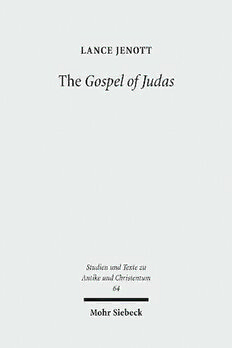
The Gospel of Judas: Coptic Text, Translation, and Historical Interpretation of 'the Betrayer's Gospel' PDF
Preview The Gospel of Judas: Coptic Text, Translation, and Historical Interpretation of 'the Betrayer's Gospel'
Studien und Texte zu Antike und Christentum Studies and Texts in Antiquity and Christianity Herausgeber/Editors Christoph Markschies(Berlin) · Martin Wallraff(Basel) Christian Wildberg(Princeton) Beirat/Advisory Board Peter Brown(Princeton) · Susanna Elm(Berkeley) Johannes Hahn(Münster) · Emanuela Prinzivalli(Rom) Jörg Rüpke(Erfurt) 64 Lance Jenott The Gospel of Judas Coptic Text, Translation, and Historical Interpretation of the ‘Betrayer’s Gospel’ Mohr Siebeck Lance Jenott, born 1980; studied History, Classics, and Religion at the University of Washington (Seattle) and Princeton University; holds a Ph.D. in the Religions of Late Antiquity from Princeton University. e-ISBN PD 978-3-16-151766-2 ISBN 978-3-16-150978-0 ISSN 1436-3003 (Studien und Texte zu Antike und Christentum) The Deutsche Nationalbibliothek lists this publication in the Deutsche Nationalbiblio- graphie; detailed bibliographic data are available in the Internet at http://dnb.d-nb.de. © 2011 by Mohr Siebeck, Tübingen, Germany. This book may not be reproduced, in whole or in part, in any form (beyond that permitted by copyright law) without the publisher’s written permission. This applies particularly to reproductions, translations, microfilms and storage and processing in electronic systems. The book was printed by Laupp & Göbel in Nehren on non-aging paper and bound by Buchbinderei Nädele in Nehren. Printed in Germany. For my Parents, John Jenott and Sylvia Clarke Riddell Acknowledgements This book is a revised version of my doctoral thesis which I completed in Fall 2010 at Princeton University. I owe a great deal of thanks to eve- ryone who contributed to it over the years. I must first thank my doctoral supervisor, Elaine Pagels, who sharpened my ideas and carefully read drafts of each chapter. My mentors at Princeton – John Gager, Martha Himmelfarb, Anne Marie Luijendijk, Peter Schäfer, and Christian Wild- berg – opened my mind to new worlds and provided invaluable advice. I would also like to thank my mentors at the University of Washington in Seattle: Michael Williams played a formative role in my education, and I owe him an indelible debt of gratitude. Daniel C. Waugh, Carol G. Tho- mas, Scott Noegel, Martin Jaffee, and Christopher Vanneson of Pierce College all showed me the virtue of historical studies. A special thanks must go to my dear friends at Princeton, especially Eduard Iricinschi and Philippa Townsend with whom I first read the Gospel of Judas, and to Geoff Smith, Mika Ahuvia, and Alex Kocar who commented on drafts of the chapters and consistently provided valuable insight. I am grateful for my many other friends who brought cheer over the years, especially Ginny Clark, Mairaj Syed, Joel Blecher, Rachel Lindsey, and Sarit Kattan Gribetz. I must also thank the dedicated ad- ministrators of Princeton’s Religion Department, Lorraine Fuhrmann, Pat Bogdziewicz, Kerry Smith, Mary Kay Bodnar, and Jeff Guest. John Turner and his wife Elizabeth Sterns deserve special recognition for the unforgettable time they made available to me in Lincoln. I have also gained many insights from conversations with Patricia Crone, Karen King, Christoph Markschies, and Louis Painchaud. I thank everyone in the Nordic Nag Hammadi and Gnosticism Network, especially Ismo Dunderberg, Antti Marjanen, Einar Thomassen, Uwe-Karsten Plisch, Tuomas Rasimus, Christian Bull, René Falkenberg, Katrine Brix, Mikael Haxby, Dylan Burns, Tilde Bak, Outi Lehtipuu, Nanna Liv Olsen, Johanna Brankaer, Päivi Vähäkangas, Alin Suciu, and Hugo Lundhaug. Finally I would like to thank my mother and father, to whom this book is dedicated, and my brothers Eric and Logan for their enduring love. Princeton, New Jersey, 2011 Lance Jenott Table of Contents Acknowledgements............................................................................VII Introduction.......................................................................................1 Chapter 1: Jesus’ Sacrifice ‘for the Salvation of Humanity’.....7 A. Introduction: Christus Victor............................................................7 B. Docetic or Two-Natures Christology?.............................................11 I. Phantasmal Docetism...................................................................14 II. Separationist Docetism................................................................15 III. Jesus’ Two Natures.....................................................................17 C. The Sacrificial Interpretation of Jesus’ Death..................................23 D. Baptism as Reenactment of Christus Victor....................................30 E. The Exaltation of Adam’s Great Race.............................................33 F. Conclusion......................................................................................36 Chapter 2: The Twelve Disciples.................................................37 A. Introduction....................................................................................37 B. Politics of the Eucharist..................................................................44 C. The Disciples’ Eucharist.................................................................47 D. The Temple Vision.........................................................................56 E. The Future of the Apostolic Cult.....................................................63 I. The Identity of the Figure in 40.3................................................64 II. The Meaning of (cid:2)(cid:3)(cid:4)(cid:5)(cid:6)(cid:7)(cid:8)(cid:9)(cid:3)(cid:5).......................................................65 III. Those who say ‘We are equal to angels’......................................66 F. Conclusion......................................................................................68
